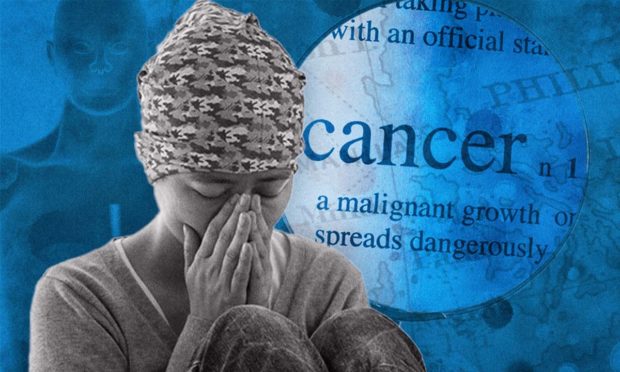
INQUIRER.net COMPOSITE / Jerome Cristobal
MANILA, Philippines — Cancer control advocates are seeking an allocation of at least P5 billion next year for the government’s cancer treatment program, about five times the current funding, to better serve the needs of patients and public hospitals that are still lacking access to medicines and proper health-care infrastructure.
The limited supply of medicines and lack of funding for the program have forced some patients to stop treatment in the middle of their cycles, according to Aileen Antolin, a trustee of the Philippine Foundation for Breast Care, which serves indigent patients at the East Avenue Medical Center in Quezon City, a hospital run by the Department of Health (DOH).
“This is a persistent problem [faced by cancer patients]…. And it happened last year. Hospitals had no supply for five to six months,” Antolin said in an Inquirer interview, adding that this was the common concern of cancer patients who had reached out to her for assistance.
“Timing is very important” for cancer treatment to be “adequate,” she said, stressing that the proper interval between cycles should be followed. “We need to be more proactive in projecting the needs of cancer patients in the coming years. So the P5 billion will be enough to cover their needs.”
P500M granted
Carmen Auste, vice president of Cancer Coalition, also urged Congress to raise the program’s budget and help the DOH meet the objectives of Republic Act No. 11215, or the National Integrated Cancer Control Act, that was enacted in 2019.
“We are thankful for the budget we now have but we need to increase it based on the data we have,” Auste said.
Advocates and health officials had lobbied for the line item allocation of the Cancer Assistance Fund (CAF) amounting to P500 million, which was recently granted by lawmakers. Aside from this, the 2023 national budget also extended the validity of the 2022 CAF allocation of P529 million until Dec. 31 this year.
Launched last year, CAF bankrolls the treatment services for eligible cancer patients, including diagnostics and therapeutic procedures.
Just 10 machines
“Will we see the line item there permanently or [will we] have to fight again for it? We are again working regularly with stakeholders to anticipate this next cycle of budget,” said Orlando Oxales, convener of Citizens Watch, another group calling for bigger CAF funding.
Antolin noted with concern that there were only about 10 mammogram machines in public hospitals nationwide, barely enough to service Filipino women who need to be screened for breast cancer.
“Our government hospitals are not equipped with the infrastructure and the manpower to be a cancer center,’’ she said. “The cancer control law provides for the building of infrastructure and machines… so that should be a huge consideration in funding.”
Aside from an increase in the salary for hospital staff, the establishment of a regional cancer center fully equipped for early detection, diagnosis, treatment and surveillance should also be funded in next year’s budget, she said.
At a media forum held last week, health experts noted that the cost of 18 treatment cycles may reach around P450,000 per patient. With a budget of about P1 billion, only about 200 patients can be covered by the program.
In case of shortage
According to Antolin, the government procures generic medicines, including those used for targeted therapy, a more advanced approach that attacks only cancer cells and spares the good cells.
But while generics are economical and just as effective as branded medicines, she said, the government should also fund the purchase of branded versions of cancer medicines to cover supply issues involving generics.
“The possible solution… is for the [government] to consider procuring branded ones when there is shortage [of supply] from generic suppliers,” she added.
Health officials, she said, may also consider procuring a newly developed subcutaneous injection, which can be administered within 15 minutes and has less side effects. However, it costs as much as P100,000 per vial for 12 to 18 cycles, depending on the patient’s need.
“It is expensive if you only look at the price. But if you consider other factors, the patient can be more productive and the health system will not be overwhelmed because the treatment requires fewer personnel and less treatment time,” she explained.
Citing a projection made by the World Health Organization, Antolin said an “epidemic of cancer” is being anticipated in the coming years as a result of the three-year pandemic lockdown.
Based on the latest data from the Philippine Statistics Authority, cancer was the third leading cause of death in the Philippines, with 42,497 cases recorded from January to September last year.